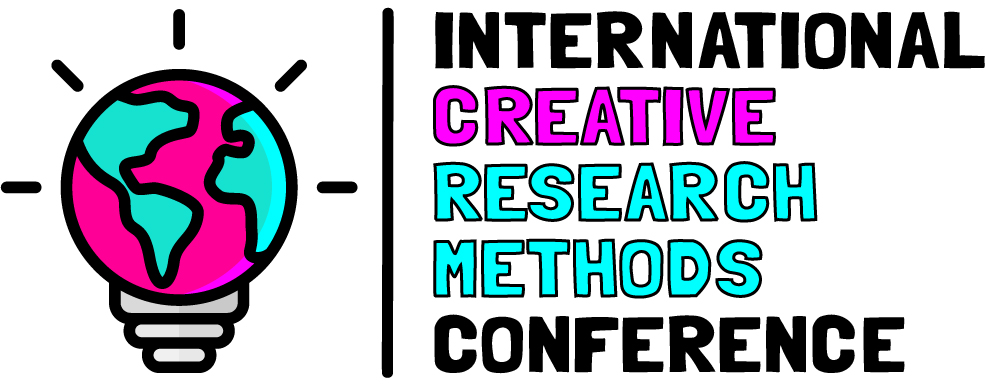
It was such an amazing couple of days! People came from Australia, New Zealand, Canada, the US, India, Nepal, Denmark, Belgium, the Netherlands, Ireland, and all over the UK – maybe other countries too but those are the ones I know about. And the people attending online were all over the world as well. This photo shows most of the 180 people at the venue for the first keynote, given by Pam Burnard from Cambridge University here in the UK. She talked about the importance of rebellion and disobedience, and demonstrated her points through poetry, sound, wool throwing, interaction, art, and dynamism. The keynote on day 2 was given by Caroline Lenette from the University of New South Wales in Sydney, Australia. She talked about anti-colonial practice and gave us a preview of her tremendous new resource: The Anti-Colonial Research Library. Both keynote speeches are now online and available for you to view via the links in this paragraph.I was astonished and delighted that both keynote speakers attended the whole conference. The biggest complaint I had from in-person delegates was that there were too many interesting sessions and it was very hard to choose. By the morning of the second day, some people were telling me they had stopped trying to decide and were picking sessions at random because they knew all the sessions would be good. There was much more laughter, and many more hugs, than I have experienced at a conference before. And we had such a diverse group of people which made for rich conversations. As well as the international diversity, there were different genders, ethnicities, abilities – we had presentations from researchers with intellectual disabilities, neurodivergent researchers, researchers with physical disabilities, and others – and a wide range of disciplines. People came from the private sector, academia, the non-profit sector, and self-employment. And everyone was willing to be generous, collegial, and supportive of others. One colleague said to me that it was an unusual conference, in his experience, because there was nobody he was trying to avoid.We did our best to make it inclusive. It wasn’t perfect; the venue doesn’t have a hearing loop, and I will raise that in my feedback because it prevented at least one person from attending. But we had a quiet room, and communication badges, and the venue was entirely accessible for those with physical disabilities including one person who came on a mobility scooter. The feedback I have heard and seen so far has been glowing. Examples include:”It was a brilliant, wonderful conference, and the best online conference that I’ve ever attended.””Excellent few days in Manchester for #ICRMC where the vibe was most welcoming and the content engaging, important and imaginative. Everything you’d want a creative methods space to be. Thanks and congrats to all involved.”And lots more in the same vein. Dawn Wink, from Santa Fe, wrote a whole blog post about the creativity, research, and passion at the conference.I have been imagining and dreaming of this conference for years. I am so, so happy that at last I have been able to do it. We didn’t make a big surplus – I don’t have the final figures yet, but I think around £3-4,000 – and that will help to fund a keynote speaker from the majority world for next year. Yes, we will be doing it again; I have already booked the venue! Save the dates: 9-10 September 2024, Manchester, England. Hope to see you there!


 I was lucky enough to spend two days last week helping with the
I was lucky enough to spend two days last week helping with the  Last week there was an interesting conference called
Last week there was an interesting conference called  You may be asked to chair an event such as a meeting, conference presentations, panel seminar, or even a whole conference. If you haven’t done this before, the prospect may fill you with dread. You’ve seen other people who have made it look easy. But nobody has ever told you how to chair an event; it’s as though you’re supposed to have learned it psychically or by osmosis or magic.
You may be asked to chair an event such as a meeting, conference presentations, panel seminar, or even a whole conference. If you haven’t done this before, the prospect may fill you with dread. You’ve seen other people who have made it look easy. But nobody has ever told you how to chair an event; it’s as though you’re supposed to have learned it psychically or by osmosis or magic.

 I picked up
I picked up 
![Creative research methods in the social sciences [FC]](https://drhelenkara.files.wordpress.com/2015/03/creative-research-methods-in-the-social-sciences-fc.jpg?w=215)
 . While this post makes some excellent points, its title and first sentence don’t differentiate between article and conference abstracts. The standfirst talks about article abstracts, but then the first sentence is, ‘Abstracts tend to be rather casually written, perhaps at the beginning of writing when authors don’t yet really know what they want to say, or perhaps as a rushed afterthought just before submission to a journal or a conference.’ This, coming so soon after the title, gives the impression that the post is about both article and conference abstracts.
. While this post makes some excellent points, its title and first sentence don’t differentiate between article and conference abstracts. The standfirst talks about article abstracts, but then the first sentence is, ‘Abstracts tend to be rather casually written, perhaps at the beginning of writing when authors don’t yet really know what they want to say, or perhaps as a rushed afterthought just before submission to a journal or a conference.’ This, coming so soon after the title, gives the impression that the post is about both article and conference abstracts.